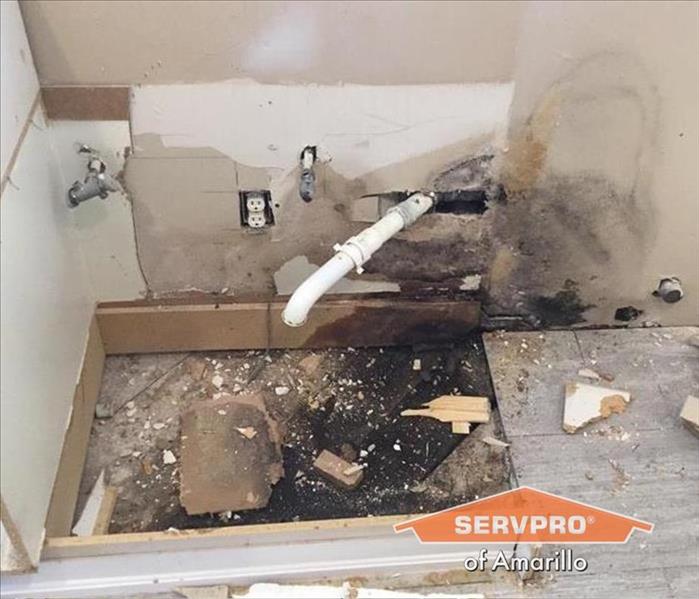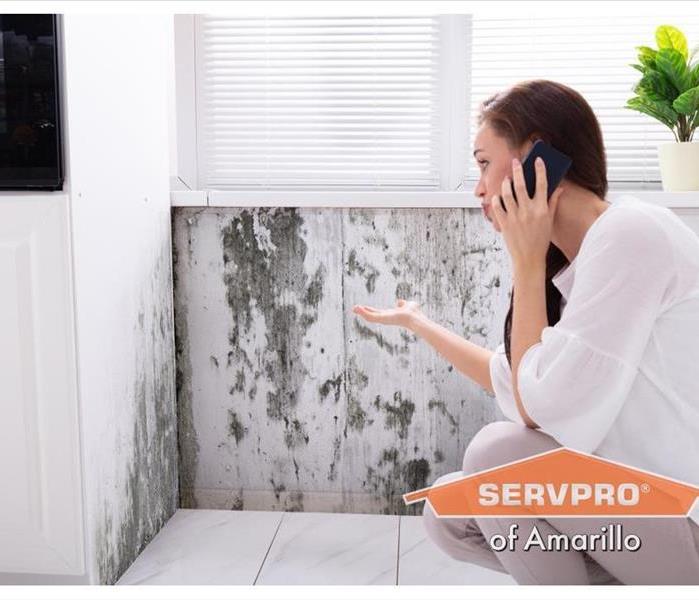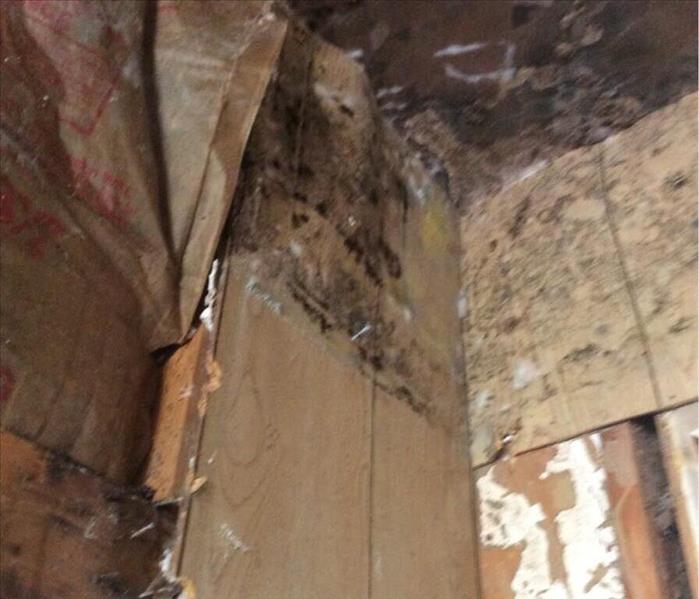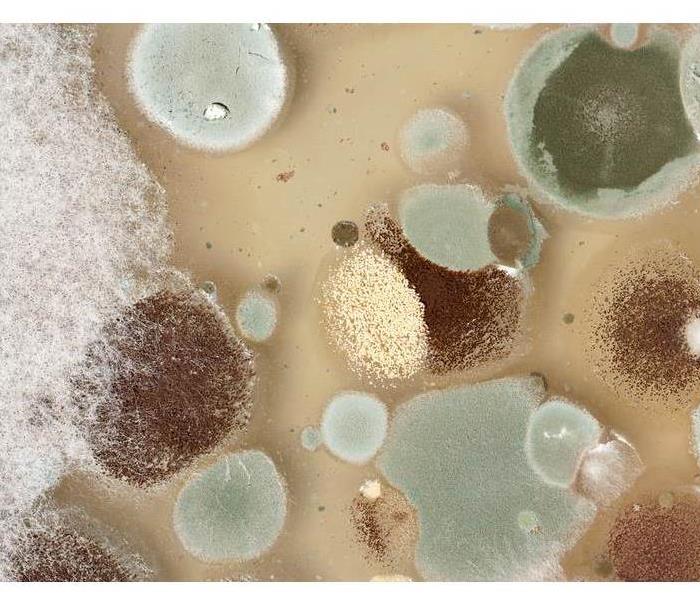Mold Remediation: Understanding Mold Damage and How to Address It
4/21/2023 (Permalink)
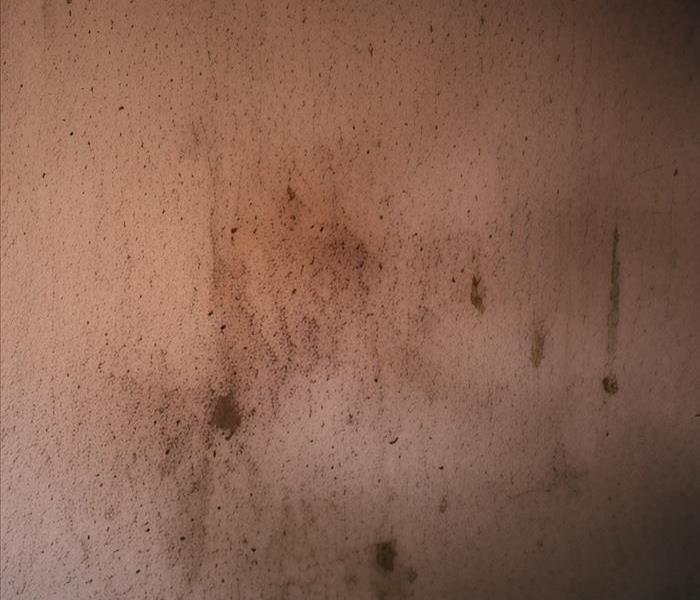 SERVPRO of Amarillo is a licensed Texas Mold Remediation Contractor with the most certified mold workers in the Panhandle.
SERVPRO of Amarillo is a licensed Texas Mold Remediation Contractor with the most certified mold workers in the Panhandle.
Mold is a fungus that grows in damp and humid environments, and it can cause severe damage to buildings and homes. Mold damage remediation is a process where mold is removed, and affected areas are restored to their pre-damaged condition.
SERVPRO of Amarillo is a licensed Texas mold remediation contractor with decades of experience. We want to help our neighbors understand mold and when to consider reaching out for professional mold removal services.
Understanding Mold Damage
Mold damage occurs when mold grows in your home or workplace. It can impact any property area, including walls, ceilings, floors, and your HVAC system. Mold growth is typically visible on surfaces in black or green spots, patches, or speckles. Mold damage can also cause a sweet and musty odor.
The impact of mold damage can be significant, and it can weaken the structure of buildings and cause wood rot, corrosion, and metal decay. Mold is notorious for spreading quickly in the right conditions. When mold spores find a moist area, they can grow and apply within as little as 24-48 hours. In some cases, mold has been known to take hold and multiply rapidly in as little as 12 hours.
The speed at which mold can spread is determined by several factors, including the amount of moisture present, the type of surface on which the mold grows, the temperature, and the humidity levels. Mold thrives in warm and humid environments but can grow in cooler temperatures as long as moisture is present.
Once mold becomes established, it can multiply and spread quickly, making addressing the issue as soon as possible imperative. If left unchecked, mold damage can cause extensive damage to your property.
Take immediate action if you suspect mold growth in your home or workplace. Due to mold's spread when left untreated, it is essential to address mold damage as quickly as possible.
Mold Remediation
Mold remediation is a specialized task that requires professional expertise. In Texas, a restoration company must be licensed. Further, each technician on-site must also be a certified mold worker for the state of Texas. Mold contractors are specially trained to understand and use specific equipment and techniques to remove mold safely and effectively.
Mold remediation typically involves six steps:
1. Assessment: The contractor will assess the extent of mold damage and determine the best course of action. A thorough assessment will help identify the scope of the mold problem and the best way to resolve it.
During the assessment phase, the mold remediation contractor will thoroughly inspect your property. They will note any visible signs of mold, moisture, and water damage on walls, ceilings, floors, and HVAC systems.
The contractor will use specialized equipment to detect moisture levels in your home or workplace. They may use a moisture meter to measure the relative humidity levels in high-risk areas, including bathrooms, kitchens, laundry rooms, and other sites prone to dampness.
The mold remediation contractor will also take air samples to determine the type and concentration of mold spores in the air.
Once the mold remediation contractor has gathered sufficient information, they will develop a remediation plan based on the extent and severity of the mold damage. The remediation plan will include the steps needed to mitigate the mold damage, including containment, removal, and disposal.
2. Containment: The contractor will isolate the area to prevent the spread of mold spores to other parts of the building. This is done by creating a physical barrier around the room with plastic sheeting. The barrier is airtight to ensure no mold spores escape the enclosed area.
To further minimize the risk of cross-contamination, the mold remediation contractor will typically use personal protective equipment when working in the containment area. This includes wearing gloves, safety goggles, and respirators to protect against mold spores.
Once the area is sealed off, the mold remediation contractor can safely remove mold-affected materials.
3. Air Filtration: In addition to the physical barrier, the mold remediation contractor may also set up a filtration system to remove mold spores from the air. Use negative air pressure to prevent the spread of mold spores further. This involves using specialized equipment to create a vacuum in the affected area and drawing air inside the containment area using a HEPA-filtered exhaust fan. This prevents mold spores from escaping the affected area and contaminating other building parts.
4. Removal: The contractor will remove all mold from surfaces, including walls, floors, and ceilings. This may include some demolition.
5. Cleaning: The contractor will clean and disinfect all surfaces to eliminate any remaining mold spores.
6. Restoration: The contractor will restore the affected area to its pre-damaged condition. This may include construction.
Different Types of Mold and Their Characteristics
Mold is a type of fungus that thrives in damp and humid environments. It comes in various shapes, sizes, and colors; these are ten common molds typically found in homes.
1. Alternaria Mold
Alternaria mold is commonly found in homes and buildings. It is a dark-colored mold that typically grows around damp areas like showers, sinks, and faucets. It has a fuzzy texture and can be recognized by its tiny and round spores.
2. Cladosporium Mold
Cladosporium mold is also commonly found in homes and buildings. It grows in damp and humid areas like basements and bathrooms. It is a greenish-black mold and has a powdery texture.
3. Aspergillus Mold
Aspergillus mold is a common indoor mold that can appear yellow, brown, white, or green. It can be found in damp and humid areas like carpets, insulation, and walls.
4. Penicillium Mold
Penicillium mold is a green or blue mold that typically grows on food, wallpaper, and carpets. It is often responsible for causing allergies and respiratory problems.
5. Stachybotrys Mold
Stachybotrys mold is a black or dark green mold that grows in damp areas with poor ventilation. It is commonly found in water-damaged homes and buildings.
6. Fusarium Mold
Fusarium mold is typically found in soil, plant debris, and damp environments. It can appear pink, white, or gray.
7. Chaetomium Mold
Chaetomium mold is a grayish-white mold that can grow in damp and poorly ventilated areas.
8. Ulocladium Mold
Ulocladium mold is a black mold that can grow on damp surfaces like walls, carpets, and insulation.
9. Aureobasidium Mold
Aureobasidium mold is a black or brown mold that can grow on wood, wallpaper, and painted surfaces.
10. Trichoderma Mold
Trichoderma mold is a green mold that typically grows on damp surfaces like wallpaper, insulation, and carpets.
Regardless of the type of mold you see, the mold remediation process remains the same, with all safety precautions put into place before any remediation is started.
Do I Need Mold Testing?
Mold testing involves taking a sample of your mold to a lab for professional analysis. While this service is available and sometimes requested, the mold remediation process can be avoided since it's the same regardless of mold type. Therefore, we do not recommend adding the cost of mold testing to your mold remediation project.
Mold Prevention Tips
Prevention is the best way to address mold damage. Here are some tips to prevent mold growth:
1. Control Moisture: Mold thrives in humid environments. Keep humidity levels in your home or workplace below 60%. In Amarillo, this will only be a problem if your property has been flooded and not been remediated, you have a poorly insulated bathroom or laundry room, or you are in a business environment where a lot of humidity is produced.
A dehumidifier is an effective tool for controlling moisture levels in your home or workplace. It works by sucking in moist air, removing the excess humidity, and then releasing the dry air into the room. This process helps to prevent mold growth and will also improve the overall air quality in your space.
Using a dehumidifier can significantly reduce the chances of mold growth. This is because the drier air created by the dehumidifier makes it much more difficult for mold spores to survive and reproduce. Additionally, running a dehumidifier can improve your space's overall air quality by reducing allergens and other irritants.
In Amarillo, where humidity levels can be relatively low, a dehumidifier might only be required in some residential settings except for those that have undergone water damage, have a leaky roof, or have poorly insulated rooms. However, in commercial spaces with a lot of water usage or where humidity levels tend to be high, such as in indoor pools or high-humidity environments, dehumidifiers are essential for controlling moisture levels and preventing mold growth.
2. Repair Leaks: Fix any leaks in your plumbing or roof as soon as possible to prevent moisture from building up. Here are some common signs that you may have a water leak:
- High Water Bills: If your water bill suddenly increases without explanation, it could indicate a leak. Check for any visible signs of water damage or moisture in your property.
- Water Stains: Water stains on walls, ceilings, or floors clearly indicate water damage. They could be a result of a leaky pipe or roof.
- Musty Odors: A musty or moldy smell in your home or building may indicate that you have mold growth due to a water leak.
- Wet Spots: Wet spots on your walls or floors are another obvious sign of a water leak. A burst pipe or a leaking appliance could cause these spots.
- Water Meter Change: A sudden change in your water meter reading could indicate a water leak. Check for any noticeable changes in your water usage.
You must act quickly to prevent further damage if you notice any of these signs.
3. Improve Ventilation: Ensure air flows freely through your property to prevent moisture buildup. This is especially important in rooms where humidity is naturally produced, like bathrooms, laundry rooms, and kitchens. Here are a few steps you can take:
- Open Windows: Open windows on opposite sides of your home to allow cross-ventilation, which will help circulate fresh air and remove stale or moist air.
- Use Fans: Ceiling and portable fans can help improve air circulation in your home. In rooms where humidity is naturally produced, such as the bathroom or kitchen, turn on the fan during and after use to help remove excess moisture.
- Install Ventilation Systems: A ventilation system can help regulate humidity levels in your home. A dehumidifier can also be used to remove excess moisture from the air.
- Clean Air Ducts: Dirty air ducts can trap moisture and promote mold growth. Regularly cleaning your air ducts can help prevent this.
- Check Your Attic: Proper roof ventilation is essential to prevent moisture buildup in the attic. Ensure your attic is ventilated correctly by checking to see if any vents are present and not blocked by debris.
- Regular Cleaning: Regularly clean and disinfect areas prone to mold growth, such as bathrooms, kitchens, and basements. When disinfecting areas prone to mold growth, selecting the right product is essential to kill the mold effectively. Bleach is often recommended as a common household disinfectant that can effectively kill most types of mold. However, it's important to note that bleach can be harsh and unsuitable for all surfaces. There are other alternatives to bleach that people with allergies or sensitivities to harsh chemicals may prefer. One option is white vinegar, a natural and non-toxic cleaning agent, and it can effectively kill some types of mold and prevent future growth. Another alternative is hydrogen peroxide, a mild but effective disinfectant, and it can also be used to remove stains left by the mold. Tea tree oil is a natural antifungal agent that can be mixed with water and sprayed on surfaces to prevent mold growth. It's essential always to follow the instructions on the disinfectant product and take appropriate safety measures, such as wearing gloves and ensuring proper ventilation. If the mold growth is extensive or has caused significant damage, it's best to consult a professional mold remediation service for safe and effective removal.
- Professional Inspections: Have a mold inspection every year to detect any potential issues before they become problematic.
What to Know About Texas Mold Remediation Laws
In Texas, mold remediation is a task that only licensed contractors can perform. Each technician on-site must also be a certified mold worker for the state of Texas.
Mold-sized above 25 contiguous square feet must be reported to the state, and additional paperwork and permissions must be obtained to complete the remediation project. Your mold remediation contractor should be an expert in Texas mold law and should guide you every step of the way.
SERVPRO of Amarillo's Mold Remediation Team
If you're dealing with a mold problem in your home or business, choosing the right company for mold remediation is crucial. Regarding mold remediation in Amarillo, TX, and the surrounding area, SERVPRO of Amarillo is the company that stands out from the rest.
SERVPRO of Amarillo is a Texas-licensed mold remediation contractor. We have the most extensive mold-licensed technicians in the Panhandle, and we're ready to help you with any size and type of mold damage.
Our clients have trusted us for years. We have:
1. Certified Professionals: Our team comprises certified mold remediation technicians with the necessary licenses and certifications to comply with Texas state law. We follow strict protocols and industry standards to handle your mold problem effectively and safely.
2. Advanced Equipment: We use the latest and most advanced equipment available in the industry to detect and remove mold. Our team is equipped with state-of-the-art moisture meters, hygrometers, and infrared cameras to help identify the moisture source causing mold growth.
3. Rapid Response: We understand that mold can spread quickly and cause significant damage if left untreated.
4. Comprehensive Services: Our mold remediation services include removing the mold and identifying and addressing the source of the moisture causing the problem. We'll ensure that your property is thoroughly dried and sanitized to prevent future mold growth.
5. Customer Satisfaction: At SERVPRO of Amarillo, we pride ourselves on our commitment to customer satisfaction. We'll work closely with you throughout the mold remediation process to ensure that your needs are met and that you are delighted with the results.
6. Insurance Experts: We work with all major insurance companies and can help you navigate the claims process to ensure you receive the coverage you're entitled to.
If you suspect mold damage in your home or workplace, contact a professional mold remediation contractor immediately to address the issue. Working with a professional mold remediation company like SERVPRO of Amarillo can help to ensure that the mold is safely and effectively removed and the affected areas are restored to their pre-damaged condition.
Contact SERVPRO of Amarillo anytime to set up a mold consultation.
We're Here to Help.





 24/7 Emergency Service
24/7 Emergency Service
